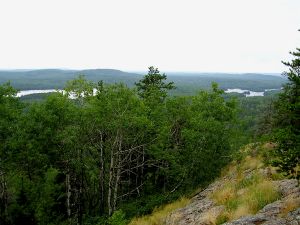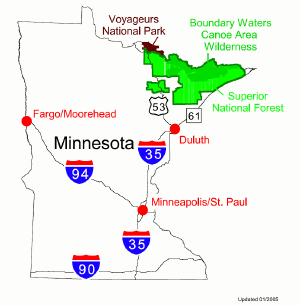Difference between revisions of "Superior National Forest" - New World Encyclopedia
Vicki Phelps (talk | contribs) (Import and credit version) |
Vicki Phelps (talk | contribs) (Images OK) |
||
| Line 1: | Line 1: | ||
| + | {{Images OK}} | ||
{{Infobox_protected_area | name = Superior National Forest | {{Infobox_protected_area | name = Superior National Forest | ||
| iucn_category = VI | | iucn_category = VI | ||
Revision as of 17:46, 31 October 2008
| Superior National Forest | |
|---|---|
| IUCN Category VI (Managed Resource Protected Area) | |
| | |
| Location: | St. Louis, Lake, and Cook counties, Minnesota, USA |
| Nearest city: | Several |
| Area: | 3,900,000 acres (6,100 mi² or 16,000 km²) |
| Established: | 1909 |
| Governing body: | U.S. Forest Service |
Superior National Forest, part of the United States National Forest system, is located in the Arrowhead Region of the state of Minnesota between the Canada – United States border and the north shore of Lake Superior. The area is part of the greater Boundary Waters region along the border of Minnesota and the Canadian province of Ontario, a historic and important thoroughfare in the fur trading and exploring days of British North America.
Under the administration of the United States Forest Service, the Superior National Forest comprises over 3,900,000 acres (6,100 mi² or 16,000 km²) of woods and waters. The majority of the forest is multiple-use, including both logging and recreational activities such as camping, boating, and fishing. Slightly over a quarter of the forest however is set aside as a wilderness reserve known as the Boundary Waters Canoe Area (BWCA), where canoers can travel along interconnected lakes and rivers and over historic portages once used by the First Nations and later by European explorers and traders.
Location
The National Forest is headquartered in Duluth, which is approximately 150 miles from the Twin Cities of Minneapolis and St. Paul, but the forest actually begins about 50 miles (80 km) north of Duluth. The forest service office at Ely is the most centrally located station within the forest; Ely is about 240 miles (385 km) from the Twin Cities and 110 miles (175 km) from Duluth.
Landforms
The forest covers 3.9 million acres (6,100 mi² or 16,000 km²), and has over 445,000 acres (1,800 km²) of water.[1] Its waters include some 2000 lakes and rivers,[2] more than 1,300 miles (2,100 km) of cold water streams, and 950 miles (1,530 km) of warm water streams.[3] Many of the lakes are located in depressions formed by the diffential erosion of tilted layers of bedded rock; these depressions were given their final form by glacial scouring during recent ice ages.[4]

The forest is located on part of the Canadian Shield. The area is on a low plateau which is part of the Superior Upland. High points include the Sawtooth Mountains, a range of hills along the shore of Lake Superior, the Misquah Hills including Eagle Mountain, the state's highest point, and other uplands along the Laurentian Divide separating the watershed of the Great Lakes and Atlantic Ocean from that of Hudson Bay and the Arctic Ocean. Despite the presence of dramatic cliffs and other local differences in elevation, the area is essentially flat, as it is part of an old peneplain eroded by weathering, water, and especially glaciers.
The principal surficial result of recent glaciation is not the deposition of glacial drift (unlike most of the rest of the state), but the remodeling of the landscape by the scraping away of softer surfaces down to bare hard rock. The land therefore is raw, with many outcroppings of ancient bedrock, overlain in places by thin layers of gravelly soil and, in the west, silts deposited by Glacial Lake Agassiz.[4]
In June 2008, legislation was introduced in the U.S. House of Representatives to sell 6,700 acres (27 km²) of land in the forest to a mining company; the company wants the land to mine deposits of "copper, nickel, platinum and palladium".[5]
Life forms
Flora
The forest contains both true boreal forest (taiga), and a mixed conifer-hardwood forest known as the North Woods, a transition province between the northern boreal forest and deciduous forests to the south.[6] Conifers include several varieties of pine, fir, and spruce trees, principal deciduous species are mountain ash, maple, aspen, oak, and paper birch are also common.[7] Characteristic aquatic plants include water lilies and wild rice.
Fauna
Fish species such as walleye, northern pike, smallmouth bass, lake trout, brook trout, rainbow trout, and brown trout can be found in abundance in the forest's waters. Larger wildlife species include white-tailed deer, moose, Canadian Lynx, American black bear, and the gray or timber wolf. Northern Minnesota has the largest population of gray wolves in the lower 48 states, with approximately 300-400 wolves within the boundaries of the Superior National Forest.[8] Located at the northern edge of the range of the hummingbird and near the southern edge of the range of the Canada Jay, the forest has 163 nesting species of birds, the largest number of any national forest.[2] Species include the Bald Eagle and other raptors, the ubiquitous common loon, and northern waterfowl.
See also
- List of U.S. national forests
- Chippewa National Forest
- List of Minnesota trees
- List of U.S. Wilderness Areas
- International Boundary Waters Treaty
- The BWCAWiki
ReferencesISBN links support NWE through referral fees
Cited references
- ↑ America's 10 Most Endangered National Forests. Report. National Forest Protection Alliance. Retrieved 2007-03-07.
- ↑ 2.0 2.1 Superior National Forest recreation. USDA Forest Service (2007-01-16). Retrieved 2007-03-07.
- ↑ Superior National Forest: About Us. USDA Forest Service (2007-02-20). Retrieved 2007-03-07.
- ↑ 4.0 4.1 4.2 Ojakangas, Richard & Charles Matsch (1982), Minnesota's Geology, Minneapolis: University of Minnesota Press, ISBN 0-8166-0953-5
- ↑ Oberstar offers bill to sell Superior Nat'l Forest land to mining company. Report. The Associated Press (2008-06-06). Retrieved 2008-06-06.
- ↑ Gibbon, Guy E.; Johnson, Craig M., and Hobbes, Elizabeth (2000). Chapter 3: Minnesota's Environment and Native American Culture History. A Predictive Model of Precontact Archaeological Site Location for The State of Minnesota. Minnesota Department of Transportation. Retrieved 2007-07-08.
- ↑ Heinselman, Miron (1996), The Boundary Waters Wilderness ecosystem, Minneapolis: University of Minnesota Press, ISBN 0-8166-2804-1 .
- ↑ Superior National Forest wildlife. USDA Forest Service (2007-01-16). Retrieved 2007-03-07.
General references
Parts of this article were taken from the Forest Service website. As a work of the U.S. federal government, the text is in the public domain.
Credits
New World Encyclopedia writers and editors rewrote and completed the Wikipedia article in accordance with New World Encyclopedia standards. This article abides by terms of the Creative Commons CC-by-sa 3.0 License (CC-by-sa), which may be used and disseminated with proper attribution. Credit is due under the terms of this license that can reference both the New World Encyclopedia contributors and the selfless volunteer contributors of the Wikimedia Foundation. To cite this article click here for a list of acceptable citing formats.The history of earlier contributions by wikipedians is accessible to researchers here:
The history of this article since it was imported to New World Encyclopedia:
Note: Some restrictions may apply to use of individual images which are separately licensed.

